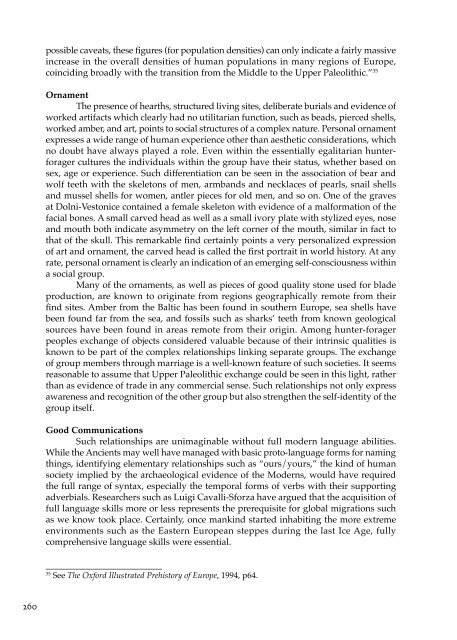The Spirit in Human Evolution - Waldorf Research Institute
The Spirit in Human Evolution - Waldorf Research Institute
The Spirit in Human Evolution - Waldorf Research Institute
Create successful ePaper yourself
Turn your PDF publications into a flip-book with our unique Google optimized e-Paper software.
possible caveats, these figures (for population densities) can only <strong>in</strong>dicate a fairly massive<br />
<strong>in</strong>crease <strong>in</strong> the overall densities of human populations <strong>in</strong> many regions of Europe,<br />
co<strong>in</strong>cid<strong>in</strong>g broadly with the transition from the Middle to the Upper Paleolithic.” 35<br />
Ornament<br />
<strong>The</strong> presence of hearths, structured liv<strong>in</strong>g sites, deliberate burials and evidence of<br />
worked artifacts which clearly had no utilitarian function, such as beads, pierced shells,<br />
worked amber, and art, po<strong>in</strong>ts to social structures of a complex nature. Personal ornament<br />
expresses a wide range of human experience other than aesthetic considerations, which<br />
no doubt have always played a role. Even with<strong>in</strong> the essentially egalitarian hunterforager<br />
cultures the <strong>in</strong>dividuals with<strong>in</strong> the group have their status, whether based on<br />
sex, age or experience. Such differentiation can be seen <strong>in</strong> the association of bear and<br />
wolf teeth with the skeletons of men, armbands and necklaces of pearls, snail shells<br />
and mussel shells for women, antler pieces for old men, and so on. One of the graves<br />
at Dolni-Vestonice conta<strong>in</strong>ed a female skeleton with evidence of a malformation of the<br />
facial bones. A small carved head as well as a small ivory plate with stylized eyes, nose<br />
and mouth both <strong>in</strong>dicate asymmetry on the left corner of the mouth, similar <strong>in</strong> fact to<br />
that of the skull. This remarkable f<strong>in</strong>d certa<strong>in</strong>ly po<strong>in</strong>ts a very personalized expression<br />
of art and ornament, the carved head is called the first portrait <strong>in</strong> world history. At any<br />
rate, personal ornament is clearly an <strong>in</strong>dication of an emerg<strong>in</strong>g self-consciousness with<strong>in</strong><br />
a social group.<br />
Many of the ornaments, as well as pieces of good quality stone used for blade<br />
production, are known to orig<strong>in</strong>ate from regions geographically remote from their<br />
f<strong>in</strong>d sites. Amber from the Baltic has been found <strong>in</strong> southern Europe, sea shells have<br />
been found far from the sea, and fossils such as sharks’ teeth from known geological<br />
sources have been found <strong>in</strong> areas remote from their orig<strong>in</strong>. Among hunter-forager<br />
peoples exchange of objects considered valuable because of their <strong>in</strong>tr<strong>in</strong>sic qualities is<br />
known to be part of the complex relationships l<strong>in</strong>k<strong>in</strong>g separate groups. <strong>The</strong> exchange<br />
of group members through marriage is a well-known feature of such societies. It seems<br />
reasonable to assume that Upper Paleolithic exchange could be seen <strong>in</strong> this light, rather<br />
than as evidence of trade <strong>in</strong> any commercial sense. Such relationships not only express<br />
awareness and recognition of the other group but also strengthen the self-identity of the<br />
group itself.<br />
Good Communications<br />
Such relationships are unimag<strong>in</strong>able without full modern language abilities.<br />
While the Ancients may well have managed with basic proto-language forms for nam<strong>in</strong>g<br />
th<strong>in</strong>gs, identify<strong>in</strong>g elementary relationships such as “ours/yours,” the k<strong>in</strong>d of human<br />
society implied by the archaeological evidence of the Moderns, would have required<br />
the full range of syntax, especially the temporal forms of verbs with their support<strong>in</strong>g<br />
adverbials. <strong>Research</strong>ers such as Luigi Cavalli-Sforza have argued that the acquisition of<br />
full language skills more or less represents the prerequisite for global migrations such<br />
as we know took place. Certa<strong>in</strong>ly, once mank<strong>in</strong>d started <strong>in</strong>habit<strong>in</strong>g the more extreme<br />
environments such as the Eastern European steppes dur<strong>in</strong>g the last Ice Age, fully<br />
comprehensive language skills were essential.<br />
_________________________<br />
35<br />
See <strong>The</strong> Oxford Illustrated Prehistory of Europe, 1994, p64.<br />
260
















